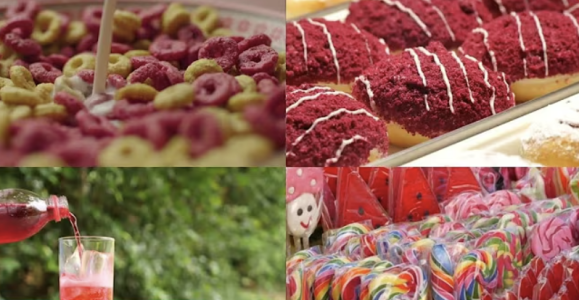Big changes are coming to your favorite snacks—here’s why
By
Veronica E.
- Replies 0
If you’ve ever reached for a box of Kraft Mac & Cheese, mixed up a glass of Kool-Aid, or grabbed a Jet-Puffed marshmallow from the pantry, you’re definitely not alone.
These colorful, comforting snacks have been part of American kitchens for generations.
Their bright colors and familiar flavors have made them household staples.
But now, those favorites may be in for a makeover.
Big changes are on the way—and the look and taste of these iconic products could shift in the very near future.

Kraft Heinz, the company behind iconic brands like Heinz ketchup, Jell-O, Crystal Light, and MiO, has announced that it plans to eliminate all artificial colors from its US products by 2027.
That means the neon red Kool-Aid, the sunny yellow mac and cheese, and the jewel-toned Jell-O cups will begin transitioning to more natural shades.
This sweeping change comes amid growing pressure from health advocates, federal officials, and public interest groups concerned about the possible health effects of synthetic dyes.
At the federal level, Health and Human Services Secretary Robert F. Kennedy Jr. has taken a firm stance, pushing for the complete removal of cancer-linked artificial dyes from the American food supply.
Artificial food dyes have been used in the US since the early 1900s.
They’ve helped make breakfast cereals, candies, beverages, and baked goods more appealing—especially to kids.
But in recent years, researchers have raised concerns about their potential link to hyperactivity in children, as well as cancer risks in animal studies.
The FDA maintains that currently approved food dyes are generally safe for the public, but that position is slowly evolving.
In January, the agency banned Red 3 after studies linked it to cancer in laboratory rats.
This spring, FDA Commissioner Dr. Marty Makary signaled plans to phase out eight more synthetic dyes—including Red 40, Yellow 5, and Blue 1—over the next two years.
According to Kraft Heinz, nearly 90% of its US products are already free from synthetic dyes.
But the remaining holdouts—such as Kool-Aid, Crystal Light, Jet-Puffed marshmallows, MiO, and Jell-O—are now undergoing reformulation.
Some may get their vibrant hues from natural sources like beet juice or carrot extract.
Others may look slightly different or even taste a little off from what you remember.
And Kraft Heinz isn’t alone.
Other major brands like Tyson Foods and W.K. Kellogg are following suit.
Even Sam’s Club, a division of Walmart, has pledged to eliminate over 40 ingredients—including artificial colors and aspartame—from its Member’s Mark private-label foods by the end of 2024.
If you’ve ever shopped for groceries abroad, you may have noticed that the colors of familiar foods seem more muted.
That’s because many countries, including Canada and those in the European Union, either restrict synthetic food dyes or require warning labels when they’re used.
These regulations have nudged food makers to use natural colorants abroad—while continuing to use artificial dyes in the US.
But that’s changing.
In addition to federal action, several states, including California and West Virginia, have introduced or passed laws limiting the use of certain artificial additives.
If this momentum continues, the US may finally align with much of the developed world when it comes to food color safety.
The process won’t happen overnight.
While the FDA’s guidelines are not yet legally binding, more companies are opting to reformulate voluntarily to stay ahead of public sentiment and possible future regulation.
Natural dyes like beet juice, turmeric, and annatto are increasingly being used to replace the vibrant synthetic reds, yellows, and blues.
Pedro Navio, president of Kraft Heinz North America, shared this in a recent statement:
“As a food company with a 150+ year heritage, we are continuously evolving our recipes, products, and portfolio. Our goal is to provide nutritious, affordable, and great-tasting food for Americans, and we take that responsibility seriously.”
It’s a fair question.
For many of us, the bright color of blue raspberry Jell-O or the golden orange of Kraft Mac & Cheese is part of the joy.
Will these foods still taste like they used to? Kraft Heinz says yes, though some subtle changes in color or texture may be noticeable.
This isn’t the first time they’ve made changes quietly—back in 2016, the company removed artificial colors and preservatives from its Mac & Cheese without fanfare.
Most people didn’t even notice.
The push to remove synthetic dyes is more than just a cosmetic update.
Health experts have warned for years that artificial colors could have hidden consequences—from behavioral issues in children to potential carcinogenic effects in adults.
Dr. Makary put it plainly when he said the goal is to help free families—and especially children—from the “toxic soup” often found in processed foods.
It’s a move that could mean cleaner, safer options on grocery store shelves in the years to come.
Read next: Is your favorite candy cancerous? 8 states hit by shocking FDA recall

Are you excited about the shift to natural food dyes? Will you miss the vibrant colors of classic snacks, or are you glad to see food manufacturers putting health first? Have you already noticed differences in taste or appearance in your go-to products?
We’d love to hear your thoughts! Share your opinions and experiences in the comments below. At The GrayVine, we believe your voice is part of the solution—and the conversation starts here..
These colorful, comforting snacks have been part of American kitchens for generations.
Their bright colors and familiar flavors have made them household staples.
But now, those favorites may be in for a makeover.
Big changes are on the way—and the look and taste of these iconic products could shift in the very near future.

As major food companies adjust their recipes, familiar favorites may soon look a little different on your plate. Image Source: YouTube / TODAY.
A major shift in America’s food supply
Kraft Heinz, the company behind iconic brands like Heinz ketchup, Jell-O, Crystal Light, and MiO, has announced that it plans to eliminate all artificial colors from its US products by 2027.
That means the neon red Kool-Aid, the sunny yellow mac and cheese, and the jewel-toned Jell-O cups will begin transitioning to more natural shades.
This sweeping change comes amid growing pressure from health advocates, federal officials, and public interest groups concerned about the possible health effects of synthetic dyes.
At the federal level, Health and Human Services Secretary Robert F. Kennedy Jr. has taken a firm stance, pushing for the complete removal of cancer-linked artificial dyes from the American food supply.
Also read: Is your favorite food banned? The truth about the ingredient behind these recent bans
Why now? What science is saying
Artificial food dyes have been used in the US since the early 1900s.
They’ve helped make breakfast cereals, candies, beverages, and baked goods more appealing—especially to kids.
But in recent years, researchers have raised concerns about their potential link to hyperactivity in children, as well as cancer risks in animal studies.
The FDA maintains that currently approved food dyes are generally safe for the public, but that position is slowly evolving.
In January, the agency banned Red 3 after studies linked it to cancer in laboratory rats.
This spring, FDA Commissioner Dr. Marty Makary signaled plans to phase out eight more synthetic dyes—including Red 40, Yellow 5, and Blue 1—over the next two years.
Also read: Are the foods you're eating safe? Why Americans are fighting to ban these common food ingredient
What this means for your favorite snacks
According to Kraft Heinz, nearly 90% of its US products are already free from synthetic dyes.
But the remaining holdouts—such as Kool-Aid, Crystal Light, Jet-Puffed marshmallows, MiO, and Jell-O—are now undergoing reformulation.
Some may get their vibrant hues from natural sources like beet juice or carrot extract.
Others may look slightly different or even taste a little off from what you remember.
And Kraft Heinz isn’t alone.
Other major brands like Tyson Foods and W.K. Kellogg are following suit.
Even Sam’s Club, a division of Walmart, has pledged to eliminate over 40 ingredients—including artificial colors and aspartame—from its Member’s Mark private-label foods by the end of 2024.
Also read: Crumbs of concern: Allergy fears spark major recall of a pantry staple
How does the US compare to other countries?
If you’ve ever shopped for groceries abroad, you may have noticed that the colors of familiar foods seem more muted.
That’s because many countries, including Canada and those in the European Union, either restrict synthetic food dyes or require warning labels when they’re used.
These regulations have nudged food makers to use natural colorants abroad—while continuing to use artificial dyes in the US.
But that’s changing.
In addition to federal action, several states, including California and West Virginia, have introduced or passed laws limiting the use of certain artificial additives.
If this momentum continues, the US may finally align with much of the developed world when it comes to food color safety.
The road to a more natural food system
The process won’t happen overnight.
While the FDA’s guidelines are not yet legally binding, more companies are opting to reformulate voluntarily to stay ahead of public sentiment and possible future regulation.
Natural dyes like beet juice, turmeric, and annatto are increasingly being used to replace the vibrant synthetic reds, yellows, and blues.
Pedro Navio, president of Kraft Heinz North America, shared this in a recent statement:
“As a food company with a 150+ year heritage, we are continuously evolving our recipes, products, and portfolio. Our goal is to provide nutritious, affordable, and great-tasting food for Americans, and we take that responsibility seriously.”
Also read: A big change is coming to your order—here’s what’s behind the switch
Will the food still taste the same?
It’s a fair question.
For many of us, the bright color of blue raspberry Jell-O or the golden orange of Kraft Mac & Cheese is part of the joy.
Will these foods still taste like they used to? Kraft Heinz says yes, though some subtle changes in color or texture may be noticeable.
This isn’t the first time they’ve made changes quietly—back in 2016, the company removed artificial colors and preservatives from its Mac & Cheese without fanfare.
Most people didn’t even notice.
Why this matters for your health
The push to remove synthetic dyes is more than just a cosmetic update.
Health experts have warned for years that artificial colors could have hidden consequences—from behavioral issues in children to potential carcinogenic effects in adults.
Dr. Makary put it plainly when he said the goal is to help free families—and especially children—from the “toxic soup” often found in processed foods.
It’s a move that could mean cleaner, safer options on grocery store shelves in the years to come.
Read next: Is your favorite candy cancerous? 8 states hit by shocking FDA recall
Key Takeaways
- Kraft Heinz has announced it will remove artificial colors from all its products by 2027, affecting iconic brands like Kraft Mac & Cheese, Kool-Aid, Jell-O, and Heinz ketchup.
- The move comes after increased concerns and regulatory pressure around the health risks of synthetic food dyes, including links to hyperactivity in children and cancer in animal studies.
- The company said nearly 90% of its US products are already free from artificial colors or synthetic dyes, and any new products in the U.S. will no longer contain artificial colorings from now on.
- Similar changes are occurring across the industry, with other major brands and retailers like Walmart’s Sam’s Club also phasing out artificial colors and additives in response to changing consumer preferences and regulatory proposals.
Are you excited about the shift to natural food dyes? Will you miss the vibrant colors of classic snacks, or are you glad to see food manufacturers putting health first? Have you already noticed differences in taste or appearance in your go-to products?
We’d love to hear your thoughts! Share your opinions and experiences in the comments below. At The GrayVine, we believe your voice is part of the solution—and the conversation starts here..






